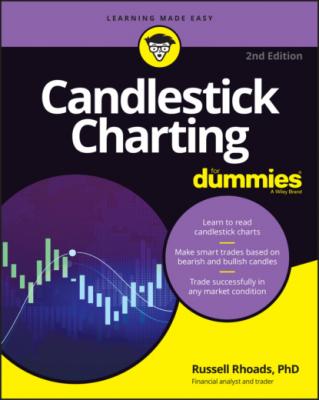ТОП просматриваемых книг сайта:
Candlestick Charting For Dummies. Russell Rhoads
Читать онлайн.Название Candlestick Charting For Dummies
Год выпуска 0
isbn 9781119869979
Автор произведения Russell Rhoads
Жанр Ценные бумаги, инвестиции
Издательство John Wiley & Sons Limited
Beyond the Book
In addition to the scintillating text in your hands, this book comes with a free access-anywhere Cheat Sheet that you can use when you need a quick refresher on common candlestick patterns or trading tips. To get this Cheat Sheet, simply go to www.dummies.com and type Candlestick Charting For Dummies Cheat Sheet in the Search box.
Where to Go from Here
To figure out which area of this book to dive into first, think hard about what facet of candlestick charting you want to understand. Do you want to get grounded in the basics or polish up on a few candlestick fundamentals that you’ve forgotten since you read that online article about candlestick charting months ago? Check out Part 1.
If you want to get cracking by finding out about a few real candlestick patterns and seeing how they can tell you what a market or security is going to do next, check out one of the chapters in Part 2 or 3. I cover many candlestick patterns in those chapters — enough to give you plenty to look for as you pore over charts on the web or in a charting software package.
You may have been exposed to some other technical indicators, and it’s possible that reading about candlesticks alongside some of that familiar material may help you get your feet wet. If so, make a beeline for Part 4, and enjoy! I’ve also added some quick summaries and resources in Part 5, so check that out, too.
The water’s fine no matter where you choose to dive in, and you’re just a few page-turns away from adding a powerful weapon to your trading arsenal.
Part 1
Getting Familiar with Candlestick Charting and Technical Analysis
IN THIS PART …
Get familiar with the mechanics of candlestick charting and how it contrasts with other methods of charting security prices.
Discover how powerful candlestick charting is relative to other, less-illustrative types of charting.
See what price activity creates candlesticks.
Understand the mind of the market based on individual candlesticks.
Explore electronic resources for creating candlestick charts and even some for identifying bullish and bearish patterns.
Chapter 1
Understanding Charting and Where Candlesticks Fit In
IN THIS CHAPTER
The advent of the Internet has leveled the playing field for securities traders. Access to markets once meant placing orders through a broker; now it’s little more than a couple of mouse clicks away. Commission rates are dramatically lower and in some cases free. Additionally, access to market information is free in many cases. Getting into securities trading is easier than ever, and the result is that a whole generation of investors and traders handles their finances without professional help. Technology allows these people to enjoy many new types of market information, and one of the best tools available is candlestick charting.
Candlestick charting methods have been around for hundreds of years, but candlesticks have caught on over the past couple of decades or so as a charting standard in the United States. I’ve been working with candlestick charts for quite a few years, and I’ve seen many traders — novice to professional — develop a fierce loyalty to candlesticks after taking the time to understand their uses and potential. I think you’ll feel the same way, and this book is the first step on your path to conquering candlesticks.
The material contained in this chapter exposes you to many of the facets of candlestick charting that continue to fuel its rise as one of the most popular charting techniques. I begin with the overall role of candlesticks within the context of charting. I cover the advantages of candlestick charting and the basics of candlestick construction. I also take the opportunity at the end of this chapter to discuss how to get started, as well as give you some insight into the characteristics and habits that successful traders employ in their pursuit of profits. Enjoy, and happy charting!
Considering Charting Methods and the Role of Candlesticks
With advancements in technology and the growing availability of trading and investing resources available to traders, many options exist for the charting of securities. There are several types of charts and dozens of variations and features to be configured on each type. It’s important that you’re clear on the options and — perhaps more important — on why candlestick charting is at the top of the heap. This section explains.
Getting a feel for your options for charting
When it comes to alternatives to candlestick charting, the three main charting contenders are as follows:
Line charts: These charts are simple and helpful for short-term decisions, but they’re quite limited in the amount of data presented.
Bar charts: These charts are the most common type and are much more useful than line charts, but they’re not as versatile as candlestick charts.
Point and figure charts: These tried-and-true charting methods are great for recognizing support and resistance levels, but they’re far less dynamic than candlestick charts.
Each one of these charting methods can be used effectively to ratchet up the effectiveness of your trading strategy, but they pale in comparison with candlestick charts for several reasons, a few of which I describe in the next section.
Realizing

